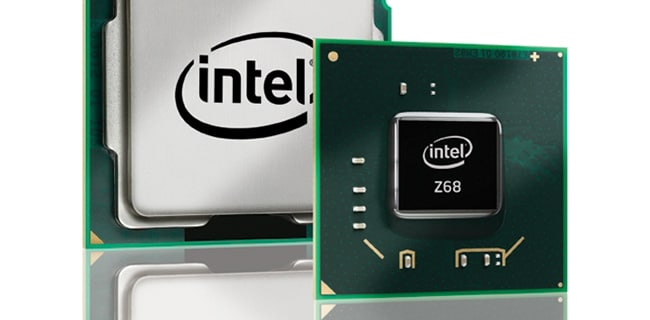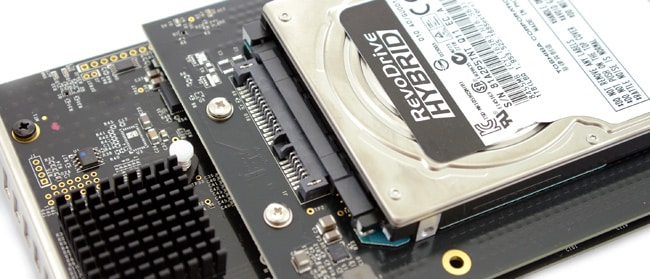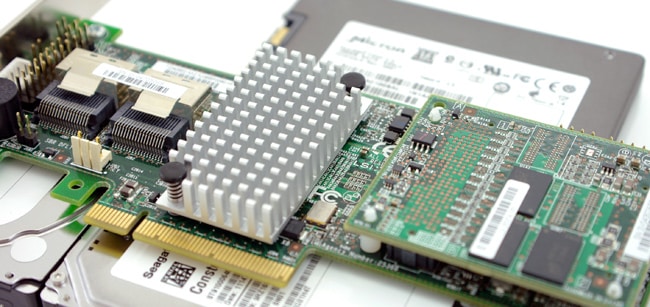With the price of platter based hard drives as low as they are (under normal conditions) and the price of solid state drives still relatively high, the concept of hybrid storage solutions; combining the low price of platter based storage with the speed of solid state drives, will become increasingly common. We are going to break down two different approaches for a hybrid storage setup; hardware-based and software-based implementations.
With the price of platter based hard drives as low as they are (under normal conditions) and the price of solid state drives still relatively high, the concept of hybrid storage solutions; combining the low price of platter based storage with the speed of solid state drives, will become increasingly common. We are going to break down two different approaches for a hybrid storage setup; hardware-based and software-based implementations.
![]()
Both hardware and software approaches have their pro’s and con’s. Software tends to be much cheaper, but also slower and dependent on the host software and hardware to work properly. Hardware, on the other hand, tends to be much more expensive, although not always, and is usually independent of the host environment, while also providing much faster speeds.
When we refer to hardware-based cache solutions, we’re generally referring to something like LSI’s CacheCade, which requires a combination of RAID card, drives and software, or the OCZ RevoDrive Hybrid, which combines storage and software into a single device. Software-based cache solutions are generally a little more hardware agnostic, primarily featuring the caching software, which is at times combined with storage hardware. We’ll dive into some of the industry-leading solutions for caching in each category next.
Intel z68 Express Chipset
Intel’s z68 chipset supports using an SSD as a cache via its RAID implementation, which they have dubbed Rapid Storage Technology. The caching part of RST is named Smart Response Technology, which essentially sets up a specialized RAID array, combining any SSD (although only 64GB will be used for caching at most) and any single drive or RAID volume into an accelerated/hybrid pair as seen by the operating system, which is Windows only for now.
The software powering the cache is supposed to be intelligent in that it only caches small, random, frequently used LBA’s, or logical block addresses, and any read larger than a few megabytes gets passed straight through the SSD cache.
Intel also claims that activities like a virus scan are also detected and subsequently bypass the cache in order to keep the cache full of only the most frequently used files. This approach does lead to significantly lower application loading times, but only if the applications files have not been kicked out of the cache due to lack of space.
The plus side is that this approach costs the user nothing more than the ssd, since the caching is part of the chipset. Another perk of this solution is caching is enabled from the get-go, instead of relying on software installed later on, making configuration pretty simple.
OCZ Synapse Caching SSD
Another software implementation is OCZ’s Synapse Cache SSD using NVLEO’s DataPlex caching software. Unlike Intel’s approach, which is dependent on the chipset and supports any SSD and hard drive, OCZ’s approach is chipset neutral. It’s all based off of NVLEO’s DataPlex software OCZ exclusively bundles with the SSD.
The drive itself is 50% over-provisioned 60GB or 120GB SATA 6.0 Gb/s Agility 3 SSD, resulting in either 30GB or 60GB of usable cache space. The caching is all done thanks to the software that once installed in Windows, provides near SSD speeds over the entire hard drive’s capacity. The software goes past first-in first-out caching methods and smartly recognizes what files should stay on the SSD with varying levels of priority over other files. While the Synapse SSDs do carry a $50 premium, the added cost goes at least in part to the DataPlex licensing fees.
Hardware based hybrid solutions usually are completely integrated solutions that are mostly independent of any additional software on the host system. Generally speaking the only software needed is the management package which interfaces with the hardware, but is not required for day-to-day operation.
OCZ’s Revodrive Hybrid, however, IS dependent on the host system. While it combines a 100GB SSD and a 1TB HDD onto a single PCI-Express card, it requires the same Dataplex software as the Synapse Cache to function. However, its price is significantly higher than either of the two software methods, clocking in at $499. However, for that price you do get a twin SF-2200-powered SSD that is theoretically capable of 910MB/s and 120,00 IOPS, more than the 550MB/s and 80,000 IOPS the 128GB Synapse Cache can muster. The PCIe card is also easy to install, with just a single card that needs to be inserted into a PC.
Seagate Momentus XT
The Seagate Momentus XT is another hardware oddball in that it is much cheaper than every other approach mentioned but Intel’s, and is also completely independent of the host hardware and software. The Momentus XT is essentially a 2.5” 7200rpm 500GB HDD paired with 4GB of SLC NAND on-board. The cache is used exclusively for reads, so while operations like booting windows can approach ssd like swiftness, anything requiring writes will still perform slowly.
Random reads are also HDD-like due to their random nature. However, for application loading and boot time, the Momentus XT is generally faster than most HDD’s, including performance oriented desktop drives, and even approaches SSD speeds in some cases. With an average of just a $20 premium over other non-hybrid drives, this little 2.5” drive does provide a good deal of bang for the buck, plus it’s a rare caching solution that’s available to notebook users as well.
LSI MegaRAID CacheCade
LSI’s MegaRAID CacheCade software is an add-on for LSI’s new MegaRAID controller cards which allows up to 32 SSDs and/or 512GB cache to be used for the rest of the RAID arrays on the card. This allows for absolutely blazing speeds, but at a hefty price. The CacheCade software itself is $270, plus the cost of a compatible MegaRAID card, which starts at $360 for the 9260-4i. Add in SSDs and some HD’s, and the cost can increase substainially.
LSI’s solution is an enterprise-grade software and hardware combination, but for the enthusiast who is buying an LSI RAID card anyway, CacheCade is a fantastic investment.
Which Cache Solution is Best?
For office/home office work, where the most demanding activity the computer will ever do revolves around light gaming or productivity software, either Intel’s solution or the Momentus XT provide the best value. In addition to being the cheapest, they offer a massive drop in boot and application time, which will provide the biggest impact in an office/home office workload.
When moving to a more enthusiast-oriented workload consisting of more games and other I/O demanding applications, Intel and OCZ’s Synapse approaches offer the best fit. They can both be used to cache a larger secondary drive, thereby allowing the SSD to cache applications and the operating system, while falling back to the faster secondary drive for videos/movies and other large items. The RevoDrive Hybrid could also be used here, although the fact that it is limited to 1TB might be an issue.
For laptops there are few options. The first is the Momentus XT, which will work in almost any laptop that has an existing 2.5” hard drive. The second option is using the OCZ Synapse cache and pairing it to a secondary drive, although this does require a laptop like the ThinkPad W520 that supports two 2.5-inch drives or one 2.5-inch drive and an mSATA slot.
In servers and other enterprise applications, LSI’s CacheCade is the only one that really works well on a massive scale in terms of I/O capabilities and volume size. It scales extremely well, offering storage capacities reaching into datacenter levels and peaks at 512GB of SSD cache. It also offers a near universal hardware and software compatibility, with driver support on nearly every popular OS, since it only has to work with the host computer as a generic storage array. Where other hardware and software solutions are limited by OS-compatibility, LSI already offers support on most major platforms. When it comes down to it though, these perks do come at a price, with entry solutions–not including drives–cost as much as the finished product in other categories.





